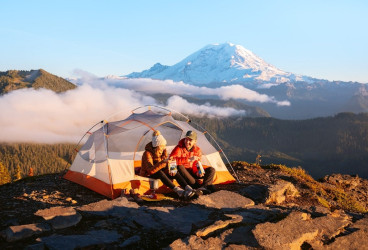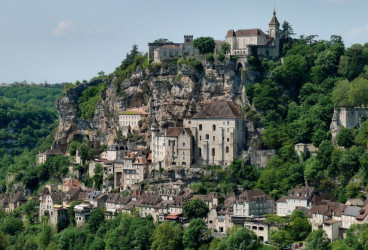The majestic forts in India are the most prominent remnants of the country's history. They bear great cultural significance and tell the tales of several historical kings, wars, and landlords. The forts have medieval architecture and can attract millions of tourists every year. Here are some of the most popular forts in India:
The Top 10 Most Popular Historical Forts in India:
01. Jaisalmer Fort, Jaisalmer:
Located in the city of Jaisalmer, the Jaisalmer Fort is believed to be one of the very few "living forts" in the world. It has an 860-year-old history and its surrounding settlements are assumed to be from the 17th century. It stands along the southern edge of the city amidst the sandy expanse of the great Thar Desert on Trikuta Hill. The massive yellow sandstone walls gain a tawny lion color during the day and fade to honey-gold as the sun sets.
Jaisalmer Fort was 460 m long and 230 m wide, and its built on a hill above a height of 76 m. It has four massive gateways, the Raj Mahal Palace, Jain Temples, and the Laxminath temple. It also houses several Merchant Havelis that were built by wealthy merchants. The fort also has numerous eateries featuring native, Italian, and French cuisines.
02. Red Fort, Delhi:
Red Fort is one of the most notable attractions in the capital city of India. The fort served as the main residence of the Mughal emperors. The Mughal Emperor Shah Jahan commissioned the construction of the Fort in 1638 when he decided to shift the capital of India from Agra to Delhi. Later on, it was selected as a UNESCO World Heritage Site in 2007.
The credit for the design of the fort was given to architect Ustad Ahmad Lahori, the constructor of the Taj Mahal. The architecture of the fort is a combination of Persianate palace architecture and Indian traditions. According to the World Heritage Convention, the Red Fort represents the zenith of Mughal creativity.
03. Mehrangarh Fort, Jodhpur:
Located on a hilltop around 122 meters above the surrounding plain, the Mehrangarh Fort covers an area of around 1,200 acres in Jodhpur. Rajput ruler Rao Jodha constructed the fort in 1459. The fort houses several palaces with intricate carvings and expansive courtyards inside its boundaries. There's also a museum inside the fort displaying various relics.
Surrounded by magnificent thick walls with imprints of the impact of cannonballs, the Mehrangarh Fort is huge and appealing. There are seven gates and seven galleries at the museum displaying a beautiful collection of weaponry, royal palanquins, paintings, costumes, and much more.
04. Agra Fort, Agra:
During the reign of Mughal emperor Akbar, the Agra Fort was built as the main residence of the rulers of the Sikarwar clan of Rajputs until the Mughals occupied it. It was inscribed as a UNESCO World Heritage Site in 1983. Covering a semicircular 94-acre area, the chord of the fort lies parallel to the river Yamuna and its walls are seventy feet high. Out of the four gates of the Agra Fort, the notable ones are the "Delhi Gate" and the "Lahore Gate." The Khizri gate opens to the Yamuna river.
Agra Fort is of great architectural significance as it was recorded that around five hundred buildings in the beautiful designs of Bengal and Gujarat were built in it. Some of the buildings were destroyed by Mughal Emperor Shah Jahan to make place for his white marble palaces. And most others were destroyed by the British troops. The remaining buildings have been preserved and are a great place to check out.
05. Chittorgarh Fort, Chittorgarh:
Also known as Chittod Fort, the Chittorgarh Fort is one of the largest forts in India. The fort stretches over an area of 691.9 acres at a hill 180 m in height. There are 65 historic structures in the fort, featuring four palaces, 20 large water bodies, 19 large temples, 4 memorials, and a few victory towers. It was declared a UNESCO World Heritage Site in 2013.
There are seven gates of the fort that had been built as massive stone structures with secure fortifications for military defense. A circular road within the fort connects all the gates and provides access to the numerous monuments (ruined palaces and 130 temples) in the fort. You must visit the Vijaya Stambha, the Kirti Stambha, Rana Kumbha's palace, the Gaumukh Reservoir, and many other notable monuments of the fort.
06. Amber Fort, Jaipur:
Amber Fort is a UNESCO World Heritage Site and the most popular attraction in Jaipur. It was built by Raja Man Singh of Amber, who wanted to make it his capital. The fort is famous for its architecture and history. The Amber Fort is also called Kila Raipur or Raipur Kila and it is located on an island in the middle of the Jumna River. The area around Amber Fort used to be a lake before the construction of the fort. The fort was built by Man Singh in 1592 AD and it took 8 years to complete it.
The architecture of Amber Fort consists of six separate main sections. There are two main gates on each side of the fort: one for receiving guests and the other for escape. There are also several small temples within the complex that were built during different periods in time but have been maintained by royal families throughout the years.
07. Gwalior Fort, Gwalior:
Gwalior Fort, also known as Gwalior Fort Palace, is located in the Gwalior District of Madhya Pradesh. It is one of the most important historical monuments in India. The fort was built by Maharaja Man Singh Tomar in the 6th century. The fort is a stunning example of Mughal architecture, with its two gates, six bastions, and a number of palaces or ‘mahals’.
The fort has been renovated many times over the years, with new additions and improvements being made to its structure. The last renovation took place in 2009 when the entire structure was repainted and freshened up with new paint jobs on all of its façades. The fort has been designated a heritage site by the Government of India due to its architectural significance and historical importance.
When you visit Gwalior Fort, you'll see that it has a very different structure than other forts. It's said that the walls have been reinforced with metal so they can withstand attacks from cannons. Inside, there are many rooms and hallways that are open to visitors—but they're still restricted in some areas because they are used by military personnel.
08. Junagarh Fort, Bikaner:
Junagarh Fort is located in Bikaner, Rajasthan, India. Rao Bika, the founder of Bikaner built it in 1478. The fort is now a protected monument and a part of the UNESCO World Heritage Site. Junagarh Fort is one of the major tourist attractions in Rajasthan. It has been listed as a UNESCO World Heritage Site since 2004. The architecture of this fort is unique and well-preserved.
The Junagarh Fort contains five gates (North, South, East, West, and Central) with two large battlemented walls enclosing an area of approximately 16 acres (6 ha). Junagarh Fort has been used by many rulers during its history including the Mughals, Marathas, and British. It was also used by the Peshwa rulers during their rule over the Maratha Empire.
09. Kumbhalgarh, Aravalli Hills:
The Kumbhalgarh fort, situated in one of the most beautiful parts of the Aravalli Hills, is one of the best-known historical monuments of Rajasthan. It is known as the 'Gateway to Delhi' due to its proximity to Delhi and its historical importance. It was built by Rana Kumbha, the maharana of the Mewar kingdom. The fort has many gates and temples.
10. Golconda Fort, Hyderabad:
Golconda Fort is one of the most famous forts in Hyderabad. It is located at the southern edge of the city, near Hussain Sagar lake. The fort was built by Qutb Shahi and his son to defend against attacks from Marathas. It is one of the few forts that has not been modified or demolished over time.
The architecture at Golconda Fort is very interesting because it was made to be similar to the traditional architecture found in Rajasthan and Gujarat. As such, it does not have any modern elements as it was built during a different era. The fort is spread over 2.5 acres and its height from top to bottom is 11 feet. The fort has many buildings like houses, mosques, temples, wells, cisterns, and ramparts. The famous Shahi Mahal (Royal Palace) is located near the Royal Mosque in Golconda Fort.
India Travel Guide: Budgeting Tips:
India is one of the cheapest travel destinations in the world. Here’s an idea of how much money you will need per day in your India trip:
- Accommodation(solo): $5-$40 per night
- Food(3 meals): $7-$50 per day
- Transportation: $7-$20 per day
How to Stay Safe in India:
Women harassment, crazy traffic, pollution, and thefts are common in India. So, always roam around with guided tour groups and avoid places which give a negative vibe. Also keep pepper spray and a small knife along for safety. Don’t go out after 8 pm.
Key Facts & Tips to You Must Remember During Travel in India:
- Make sure that you are vaccinated before going to India.
- Avoid wearing short and revealing dresses.
- Avoid eating street food if your stomach can’t handle it well.
- Keep a scarf along and wear it while entering temples, mosques or other religious places.
- Always plan to visit the tourist attractions early in the morning to avoid crowds.
- Don’t get on an overcrowded bus. Take a taxi or a rickshaw instead.
India's top 10 forts stand as magnificent testaments to the country's rich history and cultural heritage. From the imposing walls of Mehrangarh Fort in Rajasthan to the stunning architecture of Golconda Fort in Hyderabad, each fortress tells a unique story of conquest, resilience, and artistic brilliance. These forts not only offer breathtaking views and awe-inspiring architecture but also serve as windows into India's past, showcasing the diverse cultures and civilizations that have shaped the nation. Exploring these forts is not just a journey through history; it's an opportunity to immerse oneself in the soul of India, where every stone whispers tales of glory and grandeur.












{{item.get_author.first_name}} {{item.get_author.last_name}}
Level 7
5 Photos
36 Reviews
{{item.comment_txt}}
{{item_reply.get_author.first_name}} {{item_reply.get_author.last_name}}
@ {{item_reply.reply_to}}, {{item_reply.reply_txt}}